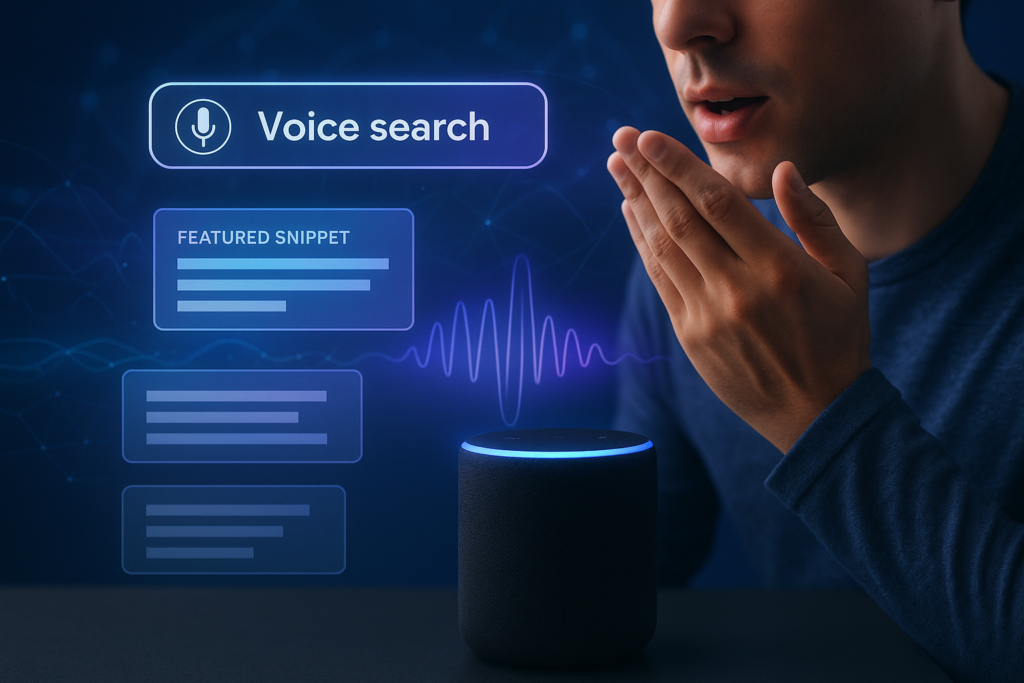The way people search for information is fundamentally changing. Instead of typing keywords into search boxes, millions now simply speak to their devices: “Hey Siri, where’s the nearest Italian restaurant?” “Alexa, what’s the weather forecast?” “OK Google, how do I fix a leaky faucet?” This shift from typed to spoken queries represents more than mere convenience—it’s transforming search engine optimization in ways that businesses must understand and adapt to. For business owners, marketers, and anyone with an online presence, voice search optimization isn’t just the next trend—it’s becoming essential for remaining visible and competitive in search results that increasingly prioritize conversational, question-based, and locally-focused content.
The Voice Search Revolution: Understanding the Shift
Voice search adoption has accelerated dramatically over the past several years, driven by improving technology, device proliferation, and changing user behavior.
Adoption statistics paint a clear picture of voice search’s growth trajectory. Current data shows that over 50% of internet users engage with voice search regularly, with adoption rates highest among younger demographics but growing across all age groups. Smart speaker ownership has reached over 35% of U.S. households, with Google Home, Amazon Echo, and Apple HomePod devices becoming household fixtures. Mobile voice search usage continues climbing as smartphone voice assistants improve in accuracy and functionality.
These aren’t merely trends—they represent fundamental shifts in how people interact with technology. Voice queries feel more natural than typing, particularly for multitasking situations like driving, cooking, or exercising. The friction of pulling out devices, opening apps, and typing disappears with voice commands, making information access nearly effortless.
Technology improvements driving adoption include dramatic accuracy gains in speech recognition. Modern voice assistants understand natural language with over 95% accuracy, up from 80% just several years ago. They handle accents, dialects, and conversational speech patterns far better than earlier systems. Natural language processing enables understanding of context, intent, and nuance rather than just literal keyword matching.
AI and machine learning continuously improve voice assistant capabilities through exposure to billions of queries. The systems learn from collective user interactions, recognizing speech patterns, disambiguating ambiguous queries, and delivering increasingly relevant results. This virtuous cycle of improvement and adoption accelerates voice search’s growth and sophistication.
Device ecosystem expansion beyond smartphones and smart speakers includes smart TVs, cars, wearables, and other connected devices. Voice interaction is becoming the default interface for Internet of Things devices, creating more touchpoints where users engage through spoken queries rather than typed searches.
Behavioral shifts accompany technology improvements. Users who initially felt self-conscious speaking to devices now do so naturally, even in public spaces. Voice search isn’t just replacing some typed searches—it’s creating new search occasions. People ask devices questions they might never have typed into search engines, particularly for immediate, local, or conversational information needs.
For businesses, these adoption patterns mean that audiences are increasingly discovering and evaluating products, services, and information through voice rather than traditional text search. Optimization strategies must evolve accordingly or risk becoming invisible to growing portions of search traffic.
How Voice Search Differs from Text Search
Voice and text searches exhibit fundamental differences that require distinct optimization approaches.
Query length and structure differ dramatically. Text searches average 2-3 words—”plumber Chicago,” “best pizza nearby,” “iPhone 15 price.” Voice searches average 7-10 words and take conversational form—”Who’s the best plumber in Chicago for emergency repairs?” “Where can I find authentic Italian pizza near me that’s open now?” “How much does the iPhone 15 cost and what colors does it come in?”
This length difference reflects how naturally people speak versus type. Typing encourages brevity; speaking accommodates natural conversational language. Voice users frame questions as they would when asking humans rather than crafting keyword combinations optimized for search engines.
Question-based format predominates in voice search. Over 70% of voice queries begin with question words—who, what, where, when, why, how—compared to under 10% of text searches. Users treat voice assistants as question-answering services rather than keyword retrieval systems. “How do I change a tire?” replaces “tire change instructions.” “What’s the best sushi restaurant in Seattle?” replaces “Seattle sushi.”
Local intent appears far more frequently in voice searches. Studies show that over 50% of voice searches have local intent, compared to roughly 20% of text searches. Voice queries like “near me,” “close by,” “open now,” and “directions to” dominate mobile voice search. Users leverage voice search primarily for immediate, actionable information—finding businesses, checking hours, getting directions, making reservations.
Conversational language characterizes voice queries. Users employ natural sentence structure, contractions, colloquialisms, and casual phrasing they wouldn’t type. “What’s the best way to get rid of ants in my kitchen?” versus typed “ant removal kitchen.” This conversational quality requires content written in natural language rather than keyword-stuffed text.
Intent clarity often proves higher in voice searches. The specificity and conversational nature of voice queries frequently reveals clearer user intent than cryptic keyword searches. “What symptoms indicate I should see a doctor for a cough?” communicates specific information need far better than “cough doctor.”
Featured snippet preference means voice assistants typically read single featured snippet responses rather than offering lists of results. Alexa or Google Assistant will speak one answer from what it determines is the best source, rather than offering multiple options. This zero-sum dynamic means ranking in featured snippets becomes critical for voice search visibility.
Understanding these differences enables strategic content and SEO adjustments that improve visibility in voice search results rather than optimizing solely for text-based queries.
Optimizing Content for Conversational Queries
Voice search optimization begins with content written for natural language questions rather than keyword-focused text.
Question-based content structure directly addresses common queries in your industry or niche. Rather than general informational pages, create content explicitly answering specific questions your audience asks. “How much does kitchen remodeling cost?” “What’s the best time to visit Japan?” “How do I choose a mortgage lender?”
Research tools like Answer the Public, AlsoAsked, and “People Also Ask” sections in Google search reveal common question patterns around your topics. Create comprehensive content answering these questions using the actual question phrasing as headlines or subheadings. This directly matches voice search query structures.
FAQ pages and sections provide concentrated question-answer content perfectly suited for voice search. Well-structured FAQ sections that clearly state questions and provide concise, direct answers increase likelihood of appearing in voice search results. Each question-answer pair should be marked up with schema (discussed later) to help search engines understand and potentially feature this content.
Natural, conversational language throughout content improves voice search optimization. Write as if answering questions verbally rather than composing formal business text. Use contractions, simpler sentence structures, and everyday vocabulary. The content should sound natural when read aloud—because voice assistants will literally read it aloud if it appears in results.
Long-tail keyword targeting aligns with voice search’s longer, more specific queries. Rather than optimizing for competitive short keywords (“shoes”), target longer, more specific phrases (“comfortable walking shoes for women with flat feet”). These longer phrases match how people actually speak and typically face less competition.
Complete, comprehensive answers satisfy both users and search engines. When someone asks a question via voice search, they want complete answers, not brief introductions requiring further clicking and reading. Provide thorough responses that fully address queries within single content blocks, increasing chances that search engines feature your content as the definitive answer.
Structured content hierarchy with clear headings helps search engines extract relevant answers. Use H2 and H3 tags for questions and subsections. Break content into logical segments that can stand alone as answers. This enables search engines to pull specific sections for featured snippets and voice responses rather than requiring entire pages to make sense.
Local content optimization addresses “near me” queries that dominate mobile voice search. Create location-specific content—”Best Thai Restaurants in Austin,” “Emergency Plumbers Serving Manhattan”—with clear geographic identifiers. Embed location information throughout content naturally rather than just in contact pages.
Technical SEO for Voice Search
Beyond content optimization, technical factors significantly influence voice search performance.
Schema markup and structured data help search engines understand content context and extract information for voice responses. Implement relevant schema types—FAQ schema, How-To schema, Local Business schema, Product schema—to explicitly identify content structure. Schema markup increases likelihood of appearing in featured snippets and voice assistant answers by providing search engines clear data about your content.
FAQ schema particularly benefits voice search by marking question-answer pairs in machine-readable format. Search engines can extract these structured answers directly for voice responses without needing to interpret unstructured content.
Page speed optimization becomes even more critical for voice search because users expect immediate answers. Slow-loading pages get bypassed for faster alternatives. Optimize images, minimize code, leverage caching, and use content delivery networks to ensure rapid page loads. Target loading times under 3 seconds, particularly for mobile devices where most voice searches occur.
Google’s Core Web Vitals—metrics measuring loading performance, interactivity, and visual stability—increasingly influence search rankings generally and likely affect voice search results specifically. Prioritize these technical optimizations as foundational SEO work.
Mobile optimization is non-negotiable since most voice searches occur on mobile devices. Ensure responsive design, touch-friendly interfaces, readable fonts without zooming, and mobile-appropriate content formatting. Test extensively on actual mobile devices rather than just desktop emulators. Mobile-first indexing means Google primarily uses mobile versions of content for ranking, making mobile optimization essential.
HTTPS security has become ranking signal and particularly matters for local business queries where users seek trustworthy information about physical locations and contact details. Implement SSL certificates across entire sites, not just checkout or form pages. Voice assistants may deprioritize or exclude non-secure sites from local recommendations.
Local SEO technical factors including complete, accurate Google Business Profile information, consistent NAP (Name, Address, Phone) across directories, and location-based schema markup improve visibility for local voice searches. Ensure business information is identical across your website, Google Business Profile, social media, and directory listings. Inconsistencies confuse search engines and reduce trust signals.
Site architecture and internal linking should organize content logically with clear topical clusters. Create pillar pages on broad topics with linked cluster content addressing specific related questions. This helps search engines understand site structure and topical authority while making it easier to extract specific answers for voice queries.

Featured Snippets: The Holy Grail of Voice Search
Featured snippets—the boxed answers appearing at the top of Google search results—represent prime real estate for voice search because assistants typically read featured snippet content as voice responses.
Featured snippet types include paragraph snippets (text answers), list snippets (numbered or bulleted lists), table snippets (data in table format), and video snippets. Different content types suit different snippet formats, but all increase voice search visibility when you capture position zero.
Optimizing for snippets requires identifying snippet opportunities—queries where Google already displays featured snippets—and creating content that better answers those queries than current snippet holders. Tools like SEMrush, Ahrefs, and Moz can identify existing snippet opportunities in your space.
Answer formatting matters significantly. For paragraph snippets, provide concise 40-60 word answers directly addressing queries. For list snippets, use clear numbered or bulleted lists. For table snippets, format data in actual HTML tables. The easier you make it for search engines to extract and display your content, the more likely you’ll capture snippets.
Question-answer structure explicitly stating questions as headings followed by direct answers improves snippet capture. “How long does it take to grill a steak?” as H2 heading followed by concise answer paragraph gives search engines exactly what they need to feature your content.
Comprehensive coverage within single pages addressing related questions increases chances of capturing multiple featured snippets. A comprehensive guide to a topic might earn snippet positions for numerous related queries, dramatically increasing voice search visibility across the topic area.
Monitor and refine featured snippet performance by tracking which queries trigger snippets, whether you’re capturing them, and how snippet appearance affects traffic. Iterate on content formatting and answers to improve snippet capture rates over time.
Capturing featured snippets doesn’t just increase voice search visibility—it also typically increases click-through rates from text search results, providing compounding benefits from optimization efforts.
Local Voice Search Optimization
Given voice search’s heavy local intent, local optimization becomes crucial for businesses serving geographic markets.
Google Business Profile optimization represents the foundation of local voice search visibility. Ensure complete, accurate profile information including business name, address, phone, hours, categories, attributes, and descriptions. Add high-quality photos, respond to reviews, post regular updates, and keep information current.
Google increasingly pulls local business information from Business Profiles for voice search responses, making profile optimization directly connected to voice search visibility. Incomplete or inaccurate profiles get bypassed for better-optimized competitors.
Review management influences both local search rankings and voice assistant recommendations. Actively encourage satisfied customers to leave Google reviews. Respond professionally to all reviews, positive and negative. Review quantity, recency, and ratings all factor into local search visibility.
Voice assistants sometimes mention review scores when recommending businesses—”The highest-rated Italian restaurant near you is…” —making positive reviews directly affect voice search recommendations.
Local content creation targeting neighborhood and city-specific queries improves local voice search performance. Create pages or blog posts about serving specific neighborhoods, participating in local events, or addressing local customer needs. Mention specific landmarks, neighborhoods, and local terminology naturally throughout content.
NAP consistency (Name, Address, Phone) across all online mentions—your website, Google Business Profile, social media, directories—signals legitimacy and authority to search engines. Inconsistencies create confusion and reduce trust, potentially excluding you from local voice search results. Audit and correct any inconsistencies across platforms.
Local schema markup explicitly identifies your business location, service areas, hours, and contact information in machine-readable format. Implement LocalBusiness schema on your website, supplemented by specific schema types for your industry (Restaurant, MedicalBusiness, AutoRepair, etc.).
“Near me” content optimization addresses this ubiquitous voice search modifier. While you can’t literally include “near me” in content naturally, you can optimize location-based content and ensure strong local SEO signals that help search engines match your business to “near me” queries in your area.
Voice Search for E-Commerce
E-commerce businesses face unique voice search challenges and opportunities as shopping behaviors evolve to include voice-enabled purchasing.
Product information optimization requires detailed, conversational product descriptions answering common customer questions. Rather than brief, keyword-focused descriptions, create comprehensive content addressing “What’s this product made of?” “How does it compare to alternatives?” “What sizes/colors/options are available?” “Who is this product best for?”
Voice shopping enablement through platforms like Amazon Alexa and Google Assistant allows customers to order products via voice commands. E-commerce businesses should ensure product availability through these channels and optimize product listings for voice discovery using clear, distinctive product names and comprehensive details.
Comparison content addresses common voice queries like “What’s the difference between X and Y?” or “Which is better, X or Y?” Create detailed comparison content for your products versus competitors, different product tiers, or alternative solutions. This content captures customers in research phases conducting voice searches to inform purchase decisions.
Price and availability information should be easily extractable from product pages. Structure pricing clearly with schema markup. Prominently display availability status. Voice search queries often include price questions—”How much does…” “What does… cost?”—requiring accessible, structured pricing information.
Conversational checkout processes reduce friction for voice shopping. While full voice-enabled checkout remains uncommon outside Amazon ecosystem, ensuring mobile checkout processes are streamlined prepares for future voice shopping expansion while benefiting mobile shoppers generally.
Product reviews and Q&A provide rich content addressing customer questions that often emerge as voice searches. Comprehensive review sections and product Q&A features create content matching conversational queries while providing social proof that influences purchases.
Content Strategy for Voice Search Success
Developing comprehensive content strategy addressing voice search requires different approaches than traditional SEO content planning.
Question research should drive content ideation. Use tools identifying common questions in your space. Analyze Google’s “People Also Ask” boxes. Review customer service inquiries, social media questions, and sales team FAQs. Create content explicitly answering these questions using natural question phrasing.
Conversational content formats including podcasts, video content with transcripts, and interview-style articles align naturally with voice search’s conversational nature. These formats produce content that translates well to voice responses and feels natural when read aloud by voice assistants.
Topic clusters organizing content around core topics with supporting subtopic pages help establish topical authority. Create comprehensive pillar pages addressing broad topics, with numerous supporting pages addressing specific questions and subtopics. This structure helps search engines understand your expertise while providing opportunities to capture featured snippets across numerous related queries.
Regular content updates keep information current, a particularly important factor for voice search where assistants prioritize recent, accurate information. Outdated content gets deprioritized, particularly for queries where recency matters—local information, prices, policies, trends, best practices.
Answer completeness requires providing thorough responses that fully satisfy queries without requiring users to visit multiple sources. Voice search users particularly value comprehensive answers since navigating between sources proves cumbersome through voice interfaces.
Accessibility considerations including clear structure, simple language, and logical flow benefit both voice search optimization and user experience. Content that’s easy for humans to understand and navigate is typically easier for algorithms to process and extract for voice responses.
Measuring Voice Search Performance
Tracking voice search impact requires different approaches than traditional SEO measurement since analytics platforms don’t explicitly identify voice searches.
Indirect measurement methods include monitoring featured snippet rankings, since snippet appearance correlates strongly with voice search visibility. Track which queries trigger featured snippets and whether you hold position zero for target keywords.
Traffic pattern analysis can reveal voice search signals. Mobile traffic during voice-heavy times (commutes, evening, multitasking hours) may indicate voice search traffic. Increased mobile traffic without proportional desktop increases suggests changing search behavior potentially driven by voice.
Conversational keyword rankings monitoring your positions for question-based, long-tail queries provides insights into voice search optimization effectiveness. Track rankings for “how to,” “what is,” “where can I,” and other question-based variations of your target topics.
Local search performance metrics including Google Business Profile insights, “near me” ranking positions, and local pack appearances correlate with voice search visibility since local intent dominates voice queries.
Direct user feedback through surveys or analytics events can identify voice search users. Consider adding simple surveys asking how users found you or whether they used voice search. While sample sizes may be small, direct feedback provides valuable validation.
Competitive benchmarking comparing your featured snippet capture, local rankings, and conversational keyword positions against competitors reveals relative voice search optimization effectiveness and identifies improvement opportunities.
While perfect voice search attribution remains elusive, these combined metrics provide useful proxies for understanding voice search performance and optimization impact.

Future Developments and Preparation
Voice search continues evolving rapidly, with several trends shaping future optimization strategies.
Multimodal search combining voice with visual elements is emerging as assistants add screens (Echo Show, Google Nest Hub). Users can speak queries while viewing visual results, requiring optimization for both voice and visual presentation. Product images, video content, and visual structured data become increasingly important.
Contextual understanding improvements enable assistants to handle follow-up questions, understand pronouns and references, and maintain conversation context. Optimizing for conversational sequences rather than just isolated queries becomes important as this capability matures.
Personalization based on user history, preferences, and context will increasingly influence voice search results. While businesses can’t directly optimize for personalization, providing comprehensive, authoritative content increases chances of appearing across diverse personalized results.
Voice commerce expansion beyond Amazon ecosystem will create more voice shopping opportunities. Preparing product catalogs, descriptions, and checkout processes for voice interaction positions businesses to capitalize on this growth.
Industry-specific voice applications including voice search in cars, healthcare, education, and other verticals will create specialized optimization opportunities. Businesses should monitor voice search developments in their specific industries and adapt strategies accordingly.
Privacy and consent considerations will increasingly shape voice search as regulations address voice data collection and usage. Transparent practices and compliance with emerging regulations will become competitive advantages.
Conclusion: The Voice Search Imperative
Voice search optimization isn’t speculation about distant future—it’s present necessity for businesses seeking to remain visible and competitive in search results. With over half of internet users regularly engaging voice search and adoption continuing to grow, optimization for conversational, question-based, local queries has become essential rather than optional.
The businesses thriving in voice search future will be those that act now to optimize content, technical infrastructure, and local presence for voice queries. This doesn’t require abandoning traditional SEO—it requires expanding optimization strategies to encompass natural language, conversational content, featured snippet capture, and enhanced local visibility.
For business owners and marketers, the strategic imperative is clear: begin voice search optimization immediately. Audit current content for conversational query optimization. Implement technical enhancements including schema markup and mobile optimization. Strengthen local SEO foundations. Create question-focused content matching natural speech patterns.
Voice search represents fundamental shift in information discovery, not temporary trend. The businesses recognizing and adapting to this shift gain competitive advantages in search visibility, customer acquisition, and market positioning. Those continuing to optimize exclusively for text-based keyword searches risk invisibility to growing portions of their target audiences.
The next big thing in SEO isn’t coming—it’s here. Voice search optimization separates forward-thinking businesses from those clinging to outdated strategies. The question isn’t whether to optimize for voice search, but whether you’ll do so proactively while opportunities exist or reactively after competitors have already captured dominant positions in voice search results that increasingly drive business discovery and customer acquisition.
References
- Alpine.AI. (2024). “The State of Voice Technology.” Annual Voice Commerce Report.
- BrightLocal. (2024). “Local Consumer Review Survey: Voice Search and Local Discovery.” Consumer Research.
- Google. (2023). “How People Use Voice Search: Insights from Google Assistant Data.” Google Official Blog.
- PwC. (2023). “Voice Shopping: The Future of Commerce.” Consumer Intelligence Series.
- SEMrush. (2024). “Voice Search SEO: Optimization Strategies and Performance Metrics.” SEO Research.
- Stone Temple (Perficient Digital). (2023). “Featured Snippets and Voice Search Optimization Study.” Technical SEO Research.
- Uberall. (2024). “Voice Search and Local Business Discovery.” Location Marketing Report.
- Voicebot.ai. (2024). “Smart Speaker Consumer Adoption Report.” Industry Analysis.
- Google. (2023). “Core Web Vitals: How Loading Performance Affects Rankings.” Search Central Blog.
- BrightEdge. (2023). “Voice Search Impact on Organic Search Traffic.” SEO Platform Research.
Additional Resources
- Google Search Central: https://developers.google.com/search – Official Google SEO documentation including voice search guidance
- Schema.org: https://schema.org – Complete structured data markup reference for voice search optimization
- Answer the Public: https://answerthepublic.com – Tool for discovering question-based search queries
- SEMrush Voice Search Report: https://www.semrush.com/blog/voice-search-study/ – Research and insights on voice search trends
- Moz Local SEO Resources: https://moz.com/learn/seo/local – Comprehensive local SEO guides relevant to voice search
- Google Business Profile Help: https://support.google.com/business – Official guidance for local business optimization
- Voicebot.ai: https://voicebot.ai – News and analysis on voice technology and voice search
- Search Engine Journal – Voice Search: https://www.searchenginejournal.com/voice-search-seo/ – Industry articles and optimization guides




